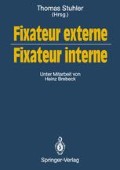Zusammenfassung
Heute wird die transphyseale Distraktion zur Korrektur von Beinlängendifferenzen im Wachstumsalter häufig angewandt. Die Methode ist von besonderem Wert bei der Korrektur von Beinlängendifferenzen, die zusammen mit Deformitäten nahe der Epiphyse auftreten [1]. Das Hauptinteresse der Methode gilt dem Einfluß der Distraktion auf das spätere Wachstum der distrahierten Epiphyse.
Preview
Unable to display preview. Download preview PDF.
Literatur
Canadell J, de Pablos J (1985) Breaking bony bridges by physeal distraction: a new approach. Int Orthop 9:223.
Crawford EJP, Jones CB, Dewar ME, Aichroth PM (1987) Distraction forces in children undergoing epiphyseal leg lengthening. Orthop Trans 11:302.
de Bastiani G, Aldegheri R, Renzi Brivo L, Trivella G (1986) Limb lengthening by distraction of the epiphyseal plate. J Bone Joint Surg [Br] 68:545.
de Bastiani G, Aldegheri R, Renzi Brivo L, Trivella G (1986) Chondrodiatasis — controlled symmetrical distraction of the epiphyseal plate. J Bone Joint Surg [Br] 68:550.
de Pablos J, Villas C, Canadell J (1986) Bone lengthening by physial distraction: an experimental study. Int Orthop 10:163.
Fishbone BM, Riley LH (1978) Continuous transphyseal distraction: experimental observations. Clin Orthop 136:120.
Hert J (1969) Acceleration of the growth after decrease of load on epiphyseal plates by means of spring distractors. Folio Morphol 17:194.
Letts RM, Meadows L (1978) Epiphysiolysis as a method of limb lengthening. Clin Orthop 133: 230.
Monticelli G, Spinelli R (1981) Distraction epiphysiolysis as a method of limb lengthening. Clin Orthop 154:254.
Peltonen J, Alitalo I, Karaharju E, Helio H (1984) Distraction of the growth plate: experiments in pigs and sheep. Acta Orthop Scand 55:359.
Porter RW (1978) The effect of tension across a growing epiphysis. J Bone Joint Surg [Br] 60:252.
Ring PA (1958) Experimental bone lengthening by epiphyseal distraction. Br J Surg 46:169.
Sledge CB, Noble J (1978) Experimental limb lengthening by epiphyseal distraction. Clin Orthop 136:111.
Smith WS, Cunningham JB (1957) The effect of alternating distracting forces on the epiphyseal plates of calves; a preliminary report. Clin Orthop 10:125.
Spriggins AJ, Woods C, Kenwright J (1987) Effects of distraction loads on the growth plate of the tibia: an experimental study. Trans Orthop Res Soc 12:492.
Author information
Authors and Affiliations
Editor information
Editors and Affiliations
Rights and permissions
Copyright information
© 1989 Springer-Verlag Berlin Heidelberg
About this paper
Cite this paper
Kenwright, J., Cunningham, J.L. (1989). Das Verhalten der Epiphysenfuge bei verschiedenen Distraktionsmethoden. In: Stuhler, T. (eds) Fixateur externe — Fixateur interne. Springer, Berlin, Heidelberg. https://doi.org/10.1007/978-3-642-74516-4_23
Download citation
DOI: https://doi.org/10.1007/978-3-642-74516-4_23
Publisher Name: Springer, Berlin, Heidelberg
Print ISBN: 978-3-642-74517-1
Online ISBN: 978-3-642-74516-4
eBook Packages: Springer Book Archive

